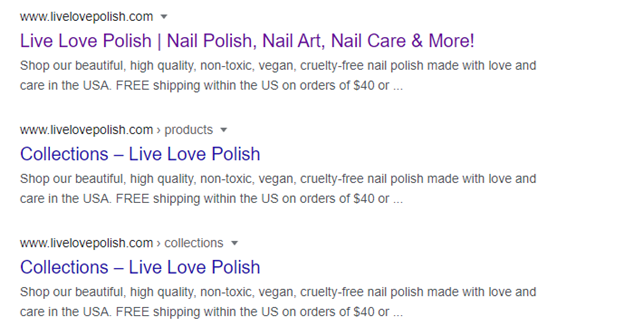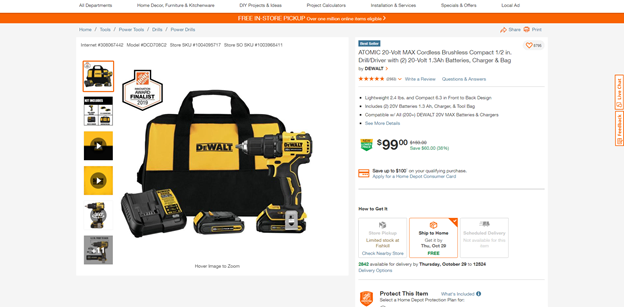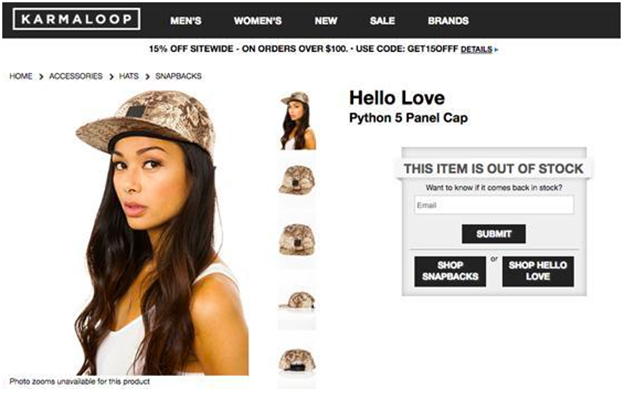Ecommerce is expected to grab even more of the retail pie, with a projected growth of nearly $11 trillion between 2021 and 2025.
An increasing number of ecommerce sites want a piece of this pie, making it critical that your search strategy delivers.
Add to this the fact that advertising costs are reaching the realm of prohibitive, only to often see sinking results, and smart SEO practices become more urgent than ever.
10 Do’s Of Ecommerce Product Page SEO
Here are 10 steps to take and 10 to avoid for a successful SEO strategy.
1. Fine-Tune Your Keyword Strategy
Keyword research is the foundation for product page optimization.
When conducting keyword research, always use product-focused topics that users are searching for. Don’t fixate on volume. Instead, think about relevancy and what will actually convert.
If you have data from other channels like paid search, use it in your keyword and topic research and incorporate ad copy with high click-through rates (CTR) into meta descriptions.
Product pages have transactional intent, so make sure your landing pages are optimized for searchers ready to buy.
Someone looking for a specific product like “Series S60l & Expression E52 paintbrush” strongly indicates they are ready to purchase it due to the detailed nature of their search.
Make it easy for them to take that next important step.
2. Optimize Titles And Meta Descriptions
Title tags and meta descriptions are very important in product page optimization.
Make sure you include details such as:
- The brand of the product, including your proprietary brand.
- The name of the product.
- The model number.
- Other important information (e.g., dimensions).
3. Mark Up Product Pages With Structured Data
Having the correct structured data type can help your brand appear in rich snippets.
All product pages should have product schema and review schema, which can:
- Drive more impressions and clicks.
- Improve your CTR and drive more sales.

4. Add Clear And Helpful FAQs
High-quality content that meets the users’ needs is key to ranking high in SERPs.
If users do not find your content useful, your bounce rates will be high, and customers may decide not to buy from you.
Most category and product pages are light on optimized content and do not have an FAQ section that is marked up with FAQ structured data.
Instead, they tend to rely on user-generated content (UGC), which is a mistake.
Suppose I have a question about a product and do not want to talk to a chatbot or call customer service.
If the brand in question has built an FAQ section with answers to questions that users commonly ask, I can easily find the information I’m looking for, and so can other customers.
That, in turn, helps the brand sell more products.
5. Always Write Unique Product And Meta Descriptions
I cannot tell you how many times I have seen an ecommerce site use the same product description for all products. This is a huge opportunity lost.
Each item can rank for branded and non-branded keywords and should therefore include a unique description to take full advantage of SEO.
Give consumers helpful, meaningful information to encourage them to click on your listing, thereby driving more traffic and sales.
 Screenshot from search, Google, August 2022
Screenshot from search, Google, August 20226. Share Real Testimonials And Customer Reviews
Product pages with customer reviews see conversion lifts of 52.2% more than their review-free counterparts, so this should be a no-brainer.
Genuine testimonials from customers, who have tried your product, speak volumes to in-market consumers trying to figure out whether or not to buy from you.
That’s why it’s so important to let customers share their experiences with your products and how they’ve helped solve problems.
But there are other advantages, too.
Reviews help build trust – especially if you have an endorsement from a carefully vetted celebrity or famous influencer.
They also provide the fresh, unique content Google craves. Just be sure to mark them up with the review schema.
 Screenshot from zoya.com, August 2022
Screenshot from zoya.com, August 20227. Test Landing Pages To Find The Best
Tools like Optimizely and Google Optimize provide an intuitive way to test even the slightest variations within product pages, which you should absolutely do to figure out the ideal configuration.
Changing the location of your call to action, for example, could drive more conversions.
Test your page layout options to see how they can best support sales.
8. Use High-Quality Video And Imagery
One of the drawbacks of shopping online is you cannot physically touch or test the product you are considering.
High-quality images and videos can fill that gap by providing end users with the information they need to feel confident in their purchases.
Recently, my search for a cordless drill led me to the Home Depot site. The company’s site ranks very high for this term, and its landing page is filled with powerful content that includes:
- Videos that answer common questions.
- Q&A with other customers.
- The imagery of what a particular kit includes.
This was a great user experience because I wanted to know how many batteries came with the drill and if it came with a bag.
 Screenshot from homedepot.com, August 2022
Screenshot from homedepot.com, August 20229. Minimize Page Load Times
Your product pages must be optimized for mobile. More and more consumers are conducting their online searches this way.
Fast-loading webpages will get your content in front of your target audience more quickly and provide a better user experience.
That, in turn, helps increase sales, revenue, and pages per session. Plus, it gives you a leg up on the competition.
It also decreases your bounce rates.
Aim for three seconds or less.
10. Audit Your Product Pages For Technical Issues
Product pages can often be duplicated because of faceted URLs, which can cause a lot of headaches for SEO, such as:
- Duplicate content.
- Wasted crawl budget.
- Split link equity.
To avoid these issues, audit your pages to see which technical and content elements need to be optimized, if any.
Problems to watch for include:
- Duplicate title tags and meta descriptions.
- Slow page load times.
- Broken links.
- Thin content.
- 404 pages.
- 302 redirects.
- Missing structured data.
10 Don’ts Of Ecommerce Product Page SEO
1. Don’t Use Product Descriptions From The Manufacturer’s Website
This is one of the most common mistakes I see in optimizing product pages.
Many manufacturer descriptions are not compelling, lack all the information a customer needs – and are not optimized for search.
It’s worth taking the time to write more informative and engaging descriptions. The more detailed information, the better. This may very well be the difference between being found and being invisible.
Also, remember that you do not want duplicate content, which will hurt your SEO efforts.
2. Don’t Kill Your Seasonal Pages Once Peak Is Past
This is a common mistake I see brands make.
While removing seasonal pages after the peak period may seem sensible, doing this will leave you with the same uphill battle every year, once again, trying to regain the authority your site needs to rank for seasonal terms.
And by the time you do this each year, it will likely be too late.
If you have a seasonal product page that has built up rankings, traffic, and sales over time, do not eliminate it.
Amazon is a great example of how to do this well. They have a dedicated Black Friday URL that only gains authority over time.
Amazon can then update the page as the peak Black Friday season approaches.
3. Don’t Use Automated Optimization
Dynamically populated product pages with the product’s name as the title tag, followed by brand and nothing else, is not a best practice.
Also, using automated descriptions and changing just a few variables could negatively impact your CTR.
Instead, include important information in the titles that you cannot automate. This can help your site rank for targeted keywords.
All titles and meta descriptions should be unique.
4. Don’t Pull Out-of-Stock Pages
Sometimes products go out of stock, especially when supply chains are stressed.
But if the product is temporarily unavailable, you should keep the URL live, especially if the page has rankings and traffic.
As with seasonal pages, this can seem counterintuitive.
In fact, a more profitable strategy is to keep these pages live and provide links to other relevant products until the item is back in stock.
 Screenshot from karmaloop.com, August 2022
Screenshot from karmaloop.com, August 20225. Don’t Use The Wrong Type Of Structured Data – Or None At All
Structured data (i.e., reviews and product data) can help your site rank in the rich results and drive more traffic and sales. Having product data can help your site rank for rich snippets.
Many brands use the wrong type of structured data or do not implement any structured data. Both hurt your site rank.
 Screenshot from Google Search Console, August 2022
Screenshot from Google Search Console, August 20226. Don’t Use Weak Calls To Action – Or Omit Them Entirely
Oftentimes, many brands do not have strong calls to action (CTA), but clean and easy CTAs are a must-have for any site.
Remember that the main job of your product page is to drive revenue and sales.
If it takes users too long to find how to purchase your products, they will instead visit your competitors’ sites. Make it easy and convincing for them to buy from you.
7. Don’t Optimize For CEO Keywords And Keywords With No Volume
Often, when a CEO asks an SEO specialist, “Why are we not ranking for XYZ keyword?” The answer is that XYZ has no search volume.
Think like a customer, do your research, and use data to inform your decisions about which keywords to use.
For example, if I’m optimizing for “lego spice girls back in stock,” it won’t be worth it because users are not really searching for this term.
Once I rank for it, I won’t get many sales because of the low volume.
8. Don’t Miss Opportunities For Internal Linking And Backlinks
Links still matter for ecommerce.
Often, brands build links to their homepages and category pages but forget about product pages.
But these pages can rank, especially for long-tail keywords that have high purchase intent and can dramatically increase revenue and sales.
That’s why you should always support product pages with internal links and even paid social to improve visibility and performance.

9. Don’t Charge The Wrong Price
Not having the right pricing strategy can cause consumers not to buy your products and possibly not to trust your brand.
This is especially true when prices spike on products high in demand, as we experienced during the baby food shortage.
We all know the laws of supply and demand, but paying 20% more for baby formula is crazy. Luckily, states are cracking down on price gouging.
10. Don’t Forget Mobile Optimization
To appreciate just how important it is to optimize for mobile shopping, consider that more than 60% of online shoppers in the U.S. shop via mobile devices. And more than one-third are mobile-only shoppers.
Not having a mobile-friendly product page can cause users to not even consider buying products from your site.
Wrapping Up
By sharpening your SEO strategy, you’re also burnishing your brand.
Giving consumers the best information there is on a product (and quickly), a compelling reason to buy, answers to their anticipated FAQs, and genuine third-party thumbs-up, you’re giving them reasons to return to your site.
Brand building is a long-term commitment. Even when it doesn’t immediately lead to a buy, it’s an assurance to customers that they can trust you.
And being vigilant about your SEO is an important way to build that trust.
More Resources:
- 21 Must-Have Features For Ecommerce Sites
- 7 Crucial Ecommerce Metrics You Should Be Tracking Right Now
- Ecommerce Marketing: The Definitive Guide
Featured Image: ImYanis/Shutterstock





![AI Overviews: We Reverse-Engineered Them So You Don't Have To [+ What You Need To Do Next]](https://www.searchenginejournal.com/wp-content/uploads/2025/04/sidebar1x-455.png)